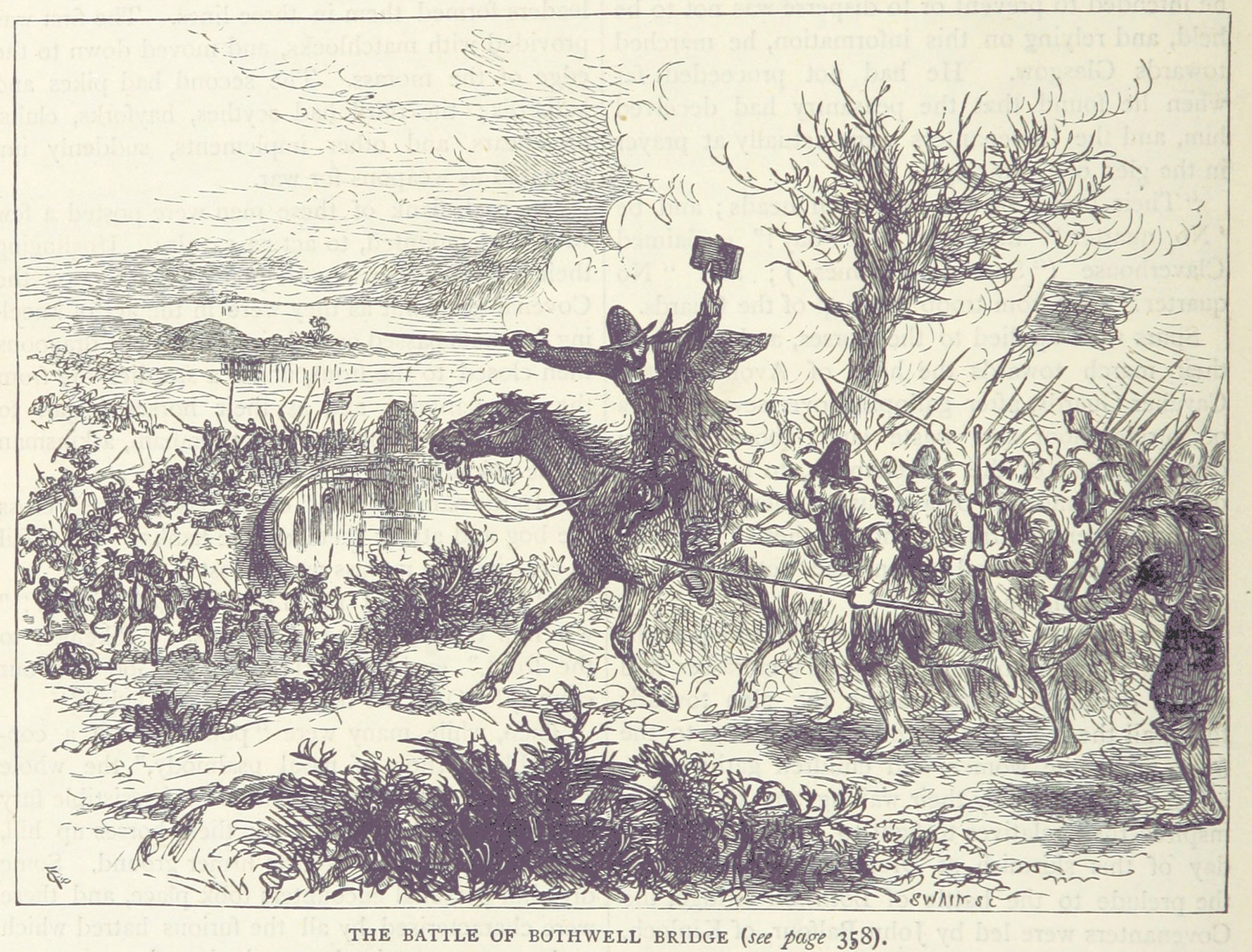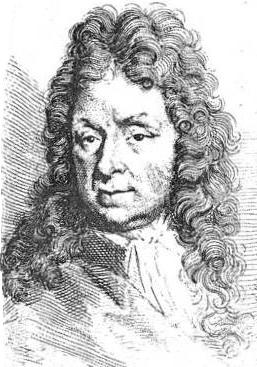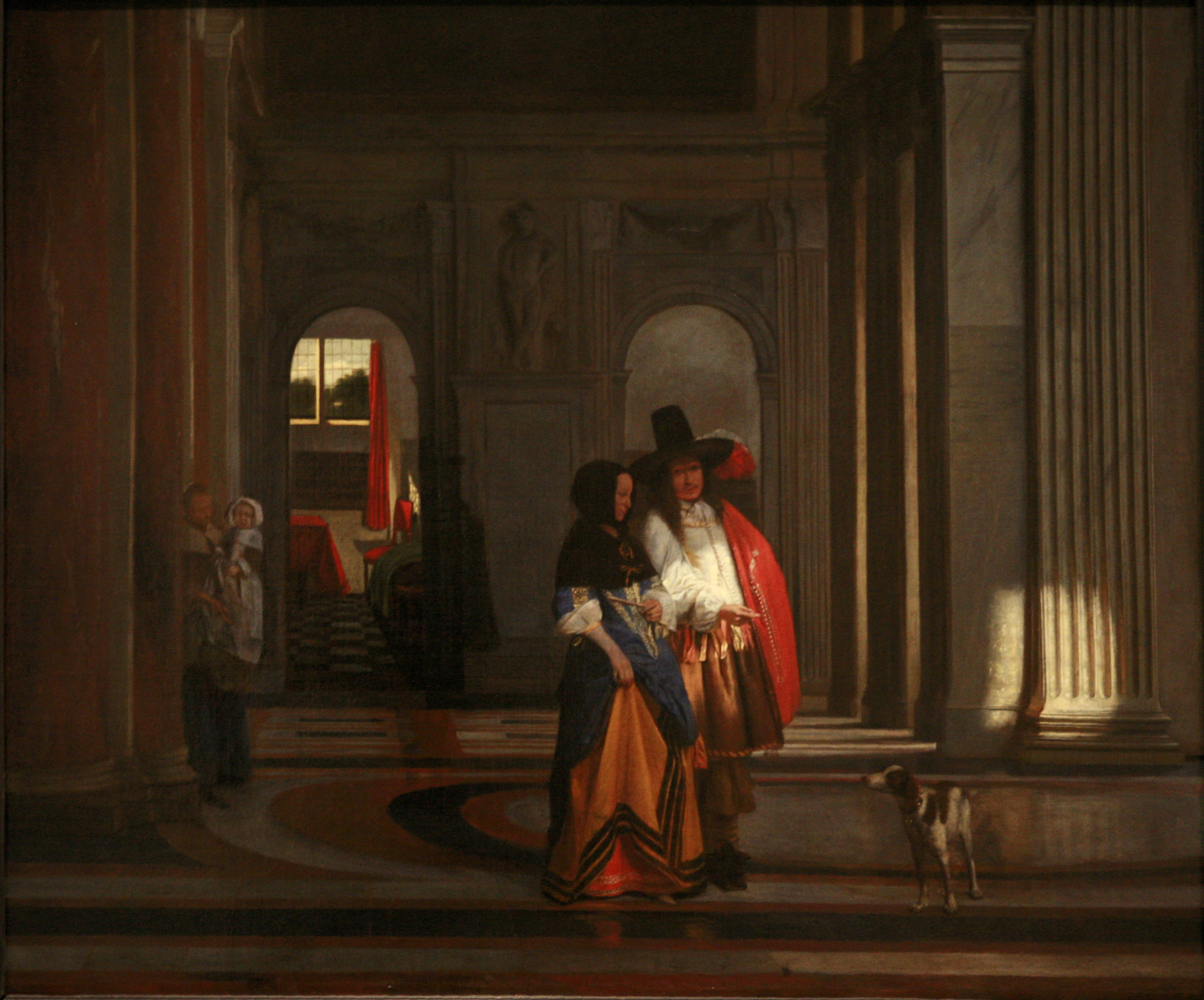|
Gerrit De Hooch
Gerrit de Hooch was a 17th-century Dutch painter of italianate landscapes, who lived and worked in The Hague (the Netherlands). He was a member of the local guild of artists, the Confrerie Pictura since 1660. Born as a son of local bailiff Eliseus de Hoog (also de Hooch) and Josina van Platen, who married in 1629 in The Hague. Gerrit's wife, Anna van Eyck (born The Hague 1629, married 1660 The Hague), is recorded widow in 1680. Anna's father was Hermanus van Eyck, who had the great philosopher Daniel Heinsius as an uncle and tutor. Gerrit himself is related to the portrait painter Dirck Cornelis de Hooch, who was his father's brother. Gerrit's son Eliseus de Hooch was a painter, too (Mr Constrijkschilder) and an engraver in silver. Eliseus worked and lived in The Hague and Rotterdam. Gerrit's daughter Josyanna Maria de Hooch married the painter Frederick Bernaerts, who lived and worked in The Hague. It is likely that Gerrit is related to the engraver Cornelis de Hooghe, who claim ... [...More Info...] [...Related Items...] OR: [Wikipedia] [Google] [Baidu] |
Italianate
The Italianate style was a distinct 19th-century phase in the history of Classical architecture. Like Palladianism and Neoclassicism, the Italianate style drew its inspiration from the models and architectural vocabulary of 16th-century Italian Renaissance architecture, synthesising these with picturesque aesthetics. The style of architecture that was thus created, though also characterised as "Neo-Renaissance", was essentially of its own time. "The backward look transforms its object," Siegfried Giedion wrote of historicist architectural styles; "every spectator at every period—at every moment, indeed—inevitably transforms the past according to his own nature." The Italianate style was first developed in Britain in about 1802 by John Nash, with the construction of Cronkhill in Shropshire. This small country house is generally accepted to be the first Italianate villa in England, from which is derived the Italianate architecture of the late Regency and early Victorian eras. ... [...More Info...] [...Related Items...] OR: [Wikipedia] [Google] [Baidu] |
Romeyn De Hooghe
Romeyn de Hooghe (bapt. 10 September 1645 – 10 June 1708) was a late Dutch Baroque painter, sculptor, engraver and caricaturist. Biography He was born in Amsterdam, and was a skilled etcher, draughtsman, painter, sculptor and medalist. He is best known for political caricatures of Louis XIV and propagandistic prints supporting William of Orange. He was also active as an erotic artist and some of his political propaganda prints can be considered early, prototypical comic strips. During his career, de Hooghe produced over 3500 prints. He also illustrated books, and his illustrations can be found in some of the most important texts of his period. The ''Hieroglyphica of Merkbeelden der oude volkeren'' (1735) was a well known emblem book and sourcebook for classical mythology and its iconography. According to Houbraken he was particularly good at inventive arrangements of subjects in engravings. He was also a gifted painter and painted large panels for the rooms of the may ... [...More Info...] [...Related Items...] OR: [Wikipedia] [Google] [Baidu] |
Dutch Golden Age Painters
Dutch Golden Age painting is the painting of the Dutch Golden Age, a period in Dutch history roughly spanning the 17th century, during and after the later part of the Eighty Years' War (1568–1648) for Dutch independence. The new Dutch Republic was the most prosperous nation in Europe and led European trade, science, and art. The northern Netherlandish provinces that made up the new state had traditionally been less important artistic centres than cities in Flanders in the south. The upheavals and large-scale transfers of population of the war, and the sharp break with the old monarchist and Catholic cultural traditions, meant that Dutch art had to reinvent itself almost entirely, a task in which it was very largely successful. The painting of religious subjects declined very sharply, but a large new market for all kinds of secular subjects grew up. Although Dutch painting of the Golden Age is included in the general European period of Baroque painting, and often shows many o ... [...More Info...] [...Related Items...] OR: [Wikipedia] [Google] [Baidu] |
1679 Deaths
Events January–June * January 24 – King Charles II of England dissolves the "Cavalier Parliament", after nearly 18 years. * February 3 – Moroccan troops from Fez are killed, along with their commander Moussa ben Ahmed ben Youssef, in a battle against rebels in the Jbel Saghro mountain range, but Moroccan Sultan Ismail Ibn Sharif is able to negotiate a ceasefire allowing his remaining troops safe passage back home. * February 5 – The Treaty of Celle is signed between France and Sweden on one side, and the Holy Roman Empire, at the town of Celle in Saxony (now in Germany). Sweden's sovereignty over Bremen-Verden is confirmed and Sweden cedes control of Thedinghausen and Dörverden to the Germans. * February 19 – Ajit Singh Rathore becomes the new Maharaja of the Jodhpur State a principality in India also known as Marwar, now located in Rajasthan state. * March 6 – In England, the "Habeas Corpus Parliament" (or "First Exclusion Parliament" ... [...More Info...] [...Related Items...] OR: [Wikipedia] [Google] [Baidu] |
1630s Births
Year 163 ( CLXIII) was a common year starting on Friday (link will display the full calendar) of the Julian calendar. At the time, it was known as the Year of the Consulship of Laelianus and Pastor (or, less frequently, year 916 ''Ab urbe condita''). The denomination 163 for this year has been used since the early medieval period, when the Anno Domini calendar era became the prevalent method in Europe for naming years. Events By place Roman Empire * Marcus Statius Priscus re-conquers Armenia; the capital city of Artaxata is ruined. Births * Cui Yan (or Jigui), Chinese official and politician (d. 216) * Sun Shao (or Changxu), Chinese chancellor (d. 225) * Tiberius Claudius Severus Proculus, Roman politician * Xun Yu, Chinese politician and adviser (d. 212) Deaths * Kong Zhou, father of Kong Rong (b. 103) * Marcus Annius Libo Marcus Annius Libo was a Roman Senator active in the early second century AD. Life Libo came from the upper ranks of the Roman aristocr ... [...More Info...] [...Related Items...] OR: [Wikipedia] [Google] [Baidu] |
Pieter Plantijn
Pieter is a male given name, the Dutch form of Peter. The name has been one of the most common names in the Netherlands for centuries, but since the mid-twentieth century its popularity has dropped steadily, from almost 3000 per year in 1947 to about 100 a year in 2016. at the Corpus of First Names in The Netherlands Some of the better known people with this name are below. See for a longer list. * (?-1332), Flemish revolutionary * (c. 1480–1572), Flemish Franciscan missionary in Mexico known as "Pedro de Gante" * |
Nicolaas Willingh
Nicolaas is the Dutch equivalent of the masculine given name Nicholas. Before the 19th century the name was also written Nicolaes, while Nikolaas is an uncommon variant spelling. Most people with the name use a short form in daily life, like ''Claas'', '' Claes'', ''Klaas'', ''Nico'', and ''Niek''. Notable people with the name Nicolaas or Nikolaas include: Academics *Nicolaas Bidloo (1673–1735), Dutch personal physician to Tsar Peter the Great *Nicolaas Bloembergen (1920–2017), Dutch-American physicist and Nobel laureate * Nicolaas Bom (born 1937), Dutch electrical engineer * Nicolaas H. J. van den Boogaard (1938–1982), Dutch medievalist scholar *Nicolaas Govert de Bruijn (1918–2012), Dutch mathematician *Nicolaas Laurens Burman (1734–1793), Dutch botanist *Nicolaas Duneas (born c. 1972), South African biotech entrepreneur * Nicolaas Everaerts (1461–1532), Dutch jurist *Nicolaas Hartsoeker (1656–1725), Dutch mathematician, physicist, and microscopist *Nicolaas Heinsi ... [...More Info...] [...Related Items...] OR: [Wikipedia] [Google] [Baidu] |
Melchior D'Hondecoeter
Melchior d'Hondecoeter (; 1636 – 3 April 1695), Dutch animalier painter, was born in Utrecht and died in Amsterdam. After the start of his career, he painted virtually exclusively bird subjects, usually exotic or game, in park-like landscapes. Hondecoeter's paintings featured geese (brent goose, Egyptian goose and red-breasted goose), fieldfares, partridges, pigeons, ducks, northern cardinal, magpies and peacocks, but also African grey crowned cranes, Asian sarus cranes, Indonesian yellow-crested cockatoos, an Indonesian purple-naped lory and grey-headed lovebirds from Madagascar. Biography Being the grandson of the painter Gillis d'Hondecoeter and the son of Gijsbert d'Hondecoeter, whose sister Josina married Jan Baptist Weenix, he was brought up in an artistic milieu.Melchior Hondecoeter in Houbrake ... [...More Info...] [...Related Items...] OR: [Wikipedia] [Google] [Baidu] |
Caspar Netscher
Caspar (or Gaspar) Netscher (1639 – January 15, 1684) was a Dutch portrait and genre painter. He was a master in depicting oriental rugs, silk and brocade and introduced an international style to the Northern Netherlands. Life According to Arnold Houbraken's 17th-century biographical study of Dutch painters he was born in Heidelberg or Prague.Gasper Netscher biography in ''De groote schouburgh der Nederlantsche konstschilders en schilderessen'' (1718) by Arnold Houbraken, courtesy of the His father ... [...More Info...] [...Related Items...] OR: [Wikipedia] [Google] [Baidu] |
Pieter De Hooch
Pieter de Hooch (, also spelled "Hoogh" or "Hooghe"; 20 December 1629 (baptized) – 24 March 1684 (buried)) was a Dutch Golden Age painter famous for his genre works of quiet domestic scenes with an open doorway. He was a contemporary of Jan Vermeer in the Delft Guild of St. Luke, with whom his work shares themes and style. Biography De Hooch was born in Rotterdam to Hendrick Hendricksz de Hooch, a bricklayer, and Annetge Pieters, a midwife. He was the eldest of five children and outlived all of his siblings. Little is known of his early life and most archival evidence suggests he worked in Rotterdam, Delft, and Amsterdam. According to his first biographer Arnold Houbraken, he studied art in Haarlem under the landscape painter Nicolaes Berchem at the same time as Jacob Ochtervelt and was known for his "kamergezichten" or "room-views" with ladies and gentlemen in conversation. [...More Info...] [...Related Items...] OR: [Wikipedia] [Google] [Baidu] |
The Hague
The Hague ( ; nl, Den Haag or ) is a city and municipality of the Netherlands, situated on the west coast facing the North Sea. The Hague is the country's administrative centre and its seat of government, and while the official capital of the Netherlands is Amsterdam, The Hague has been described as the country's de facto capital. The Hague is also the capital of the province of South Holland, and the city hosts both the International Court of Justice and the International Criminal Court. With a population of over half a million, it is the third-largest city in the Netherlands, after Amsterdam and Rotterdam. The Hague is the core municipality of the Greater The Hague urban area, which comprises the city itself and its suburban municipalities, containing over 800,000 people, making it the third-largest urban area in the Netherlands, again after the urban areas of Amsterdam and Rotterdam. The Rotterdam–The Hague metropolitan area, with a population of approximately 2.6&n ... [...More Info...] [...Related Items...] OR: [Wikipedia] [Google] [Baidu] |
Charles V, Holy Roman Emperor
Charles V, french: Charles Quint, it, Carlo V, nl, Karel V, ca, Carles V, la, Carolus V (24 February 1500 – 21 September 1558) was Holy Roman Emperor and Archduke of Austria from 1519 to 1556, King of Spain (Crown of Castile, Castile and Crown of Aragon, Aragon) from 1516 to 1556, and Lord of the Netherlands as titular Duke of Burgundy from 1506 to 1555. He was heir to and then head of the rising House of Habsburg during the first half of the 16th century, his dominions in Europe included the Holy Roman Empire, extending from Kingdom of Germany, Germany to Kingdom of Italy (Holy Roman Empire), northern Italy with direct rule over the Austrian hereditary lands and the Burgundian Low Countries, and Habsburg Spain, Spain with its southern Italy, southern Italian possessions of Kingdom of Naples, Naples, Kingdom of Sicily, Sicily, and Kingdom of Sardinia, Sardinia. He oversaw both the continuation of the long-lasting Spanish colonization of the Americas and the short-live ... [...More Info...] [...Related Items...] OR: [Wikipedia] [Google] [Baidu] |





